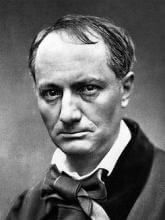
Biographie de Charles Baudelaire
Charles Pierre Baudelaire was a French poet who also produced notable work as an essayist, art critic, and pioneering translator of Edgar Allan Poe. His most famous work, a book of lyric poetry titled Les Fleurs du mal (The Flowers of Evil), expresses the changing nature of beauty in modern, industrializing Paris during the 19th century. Baudelaire's highly original style of prose-poetry influenced a whole generation of poets including Paul Verlaine, Arthur Rimbaud and Stéphane Mallarmé, among many others.
He is credited with coining the term "modernity" (modernité) to designate the fleeting, ephemeral experience of life in an urban metropolis, and art's responsibility to capture that experience. Baudelaire was a slow and fastidious worker, often sidetracked by indolence, emotional distress and illness, and it was not until 1857 that he published his first and most famous volume of poems, Les Fleurs du mal (The Flowers of Evil).
Some of these poems had already appeared in the Revue des deux mondes (Review of Two Worlds) in 1855, when they were published by Baudelaire's friend Auguste Poulet Malassis. Some of the poems had also previously appeared as "fugitive verse" in various French magazines during the previous decade. The poems found a small, appreciative audience, but greater public attention was given to their subject matter.
The effect on fellow artists was, as Théodore de Banville stated, "immense, prodigious, unexpected, mingled with admiration and with some indefinable anxious fear".Gustave Flaubert, recently attacked in a similar fashion for Madame Bovary (and acquitted), was impressed and wrote to Baudelaire : "You have found a way to rejuvenate Romanticism.... You are as unyielding as marble, and as penetrating as an English mist." The principal themes of sex and death were considered scandalous.
He also touched on lesbianism, sacred and profane love, metamorphosis, melancholy, the corruption of the city, lost innocence, the oppressiveness of living, and wine. Notable in some poems is Baudelaire's use of imagery of the sense of smell and of fragrances, which is used to evoke feelings of nostalgia and past intimacy. The book, however, quickly became a byword for unwholesomeness among mainstream critics of the day.
Some critics called a few of the poems "masterpieces of passion, art and poetry" but other poems were deemed to merit no less than legal action to suppress them.
